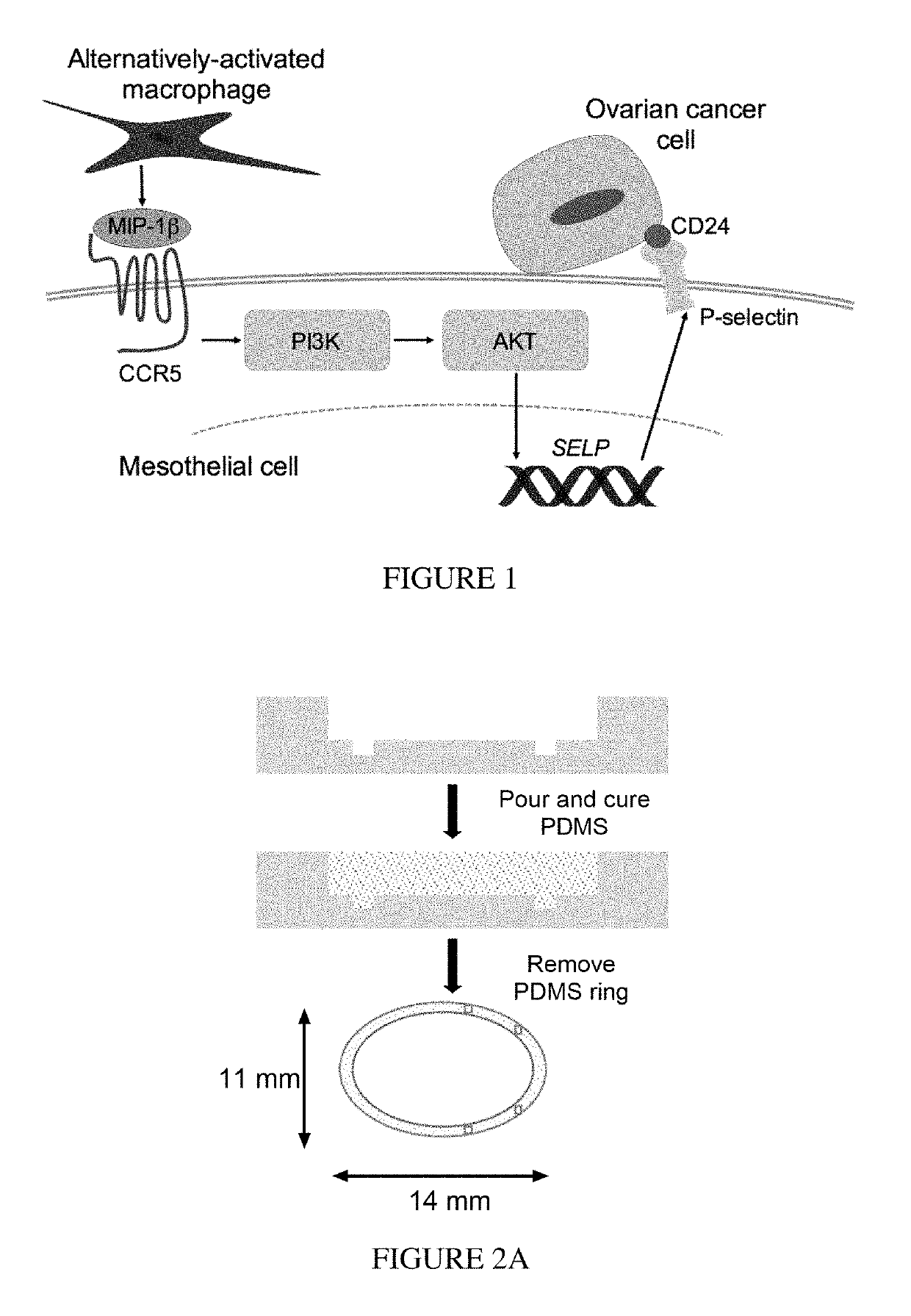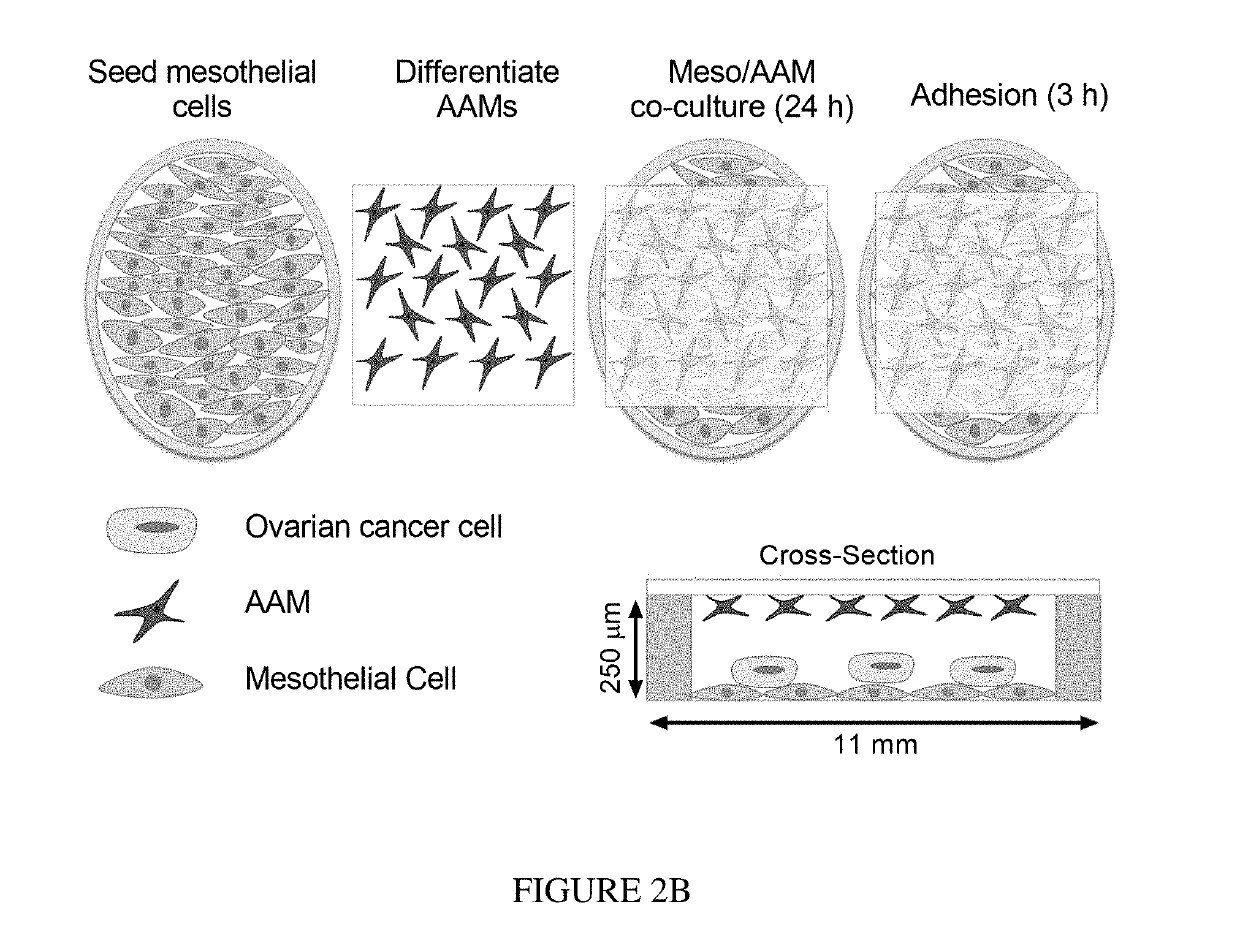Methods of inhibiting metastasis in cancer
a technology of metastasis inhibition and cancer, which is applied in the direction of immunoglobulins, peptides, drug compositions, etc., can solve the problems of limited current hgsoc treatment options, poor prognosis, and ineffective therapies for inhibiting adhesion and invasion
- Summary
- Abstract
- Description
- Claims
- Application Information
AI Technical Summary
Benefits of technology
Problems solved by technology
Method used
Image
Examples
example 1
AAMs Increase HGSOC Adhesion to Mesothelial Cells
[0080]To examine the role of AAMs in HGSOC metastasis, an in vitro model of the peritoneal microenvironment was created that enables concentrated paracrine signaling (FIG. 2A). To simulate the microenvironment of a patient with metastatic disease, and hence an increase in AAM levels, LP-9 mesothelial cells were co-cultured with primary human AAMs for 24 hours (FIG. 2B). To mimic tumor cells floating in ascites, HGOSC cells in suspension were added to the device on top of the LP-9 and allowed to adhere for three hours (FIG. 2B). After removal of non-adherent cells, HGSOC that remained were adhered to the top of the mesothelial monolayer, and had not yet invaded through the LP-9 (FIG. 3A). This is consistent with clinical observations that unlike other cancers, HGSOC does not infiltrate deeply. When AAMs were incorporated in the device, the percentage of HGSOC cells that adhered increased significantly (FIGS. 3A and 3B). Consistent with...
example 2
AAMs Regulate Mesothelial Expression of P-Selectin
[0081]Based on the observation that paracrine signals from AAMs to LP-9 enhanced adhesion, the inventors hypothesized that AAM-secreted factors upregulated extracellular matrix (ECM) or adhesion proteins on the mesothelial surface that HGSOC could then bind to. To test this hypothesis, mRNA was collected from LP-9 cultured alone or with AAMs and it was determined that 17 ECM / adhesion-related genes were downregulated, while seven genes were upregulated greater than two-fold (FIG. 3F and Table 1). Of particular interest was the increase in SELP (P-selectin), a member of the family of selectin cell adhesion molecules that other tumor cell types have been shown to bind, but has been reported to be absent in mesothelial cells in vivo and in vitro. Validation by qRT-PCR across multiple AAM donors confirmed that LP-9 had a low expression of SELF, which was upregulated nearly six-fold during AAM co-culture (FIG. 3G). To test whether P-select...
example 3
Partial Least Squares Regression (PLSR) Modeling Predicts a Role for AAM-Secreted MIP1β in Enhanced HGSOC Adhesion
[0082]It was next determined which AAM-secreted molecule(s) were responsible for the increased adhesion of HGSOC. Media was collected from adhesion assays performed with two unique AAM donors and assayed for cytokines, chemokines, and matrix metalloproteinases (MMPs) (FIG. 4A and Table 2). Of the 36 screened ligands, 25 were detectable, with some ligands such as MIP1β and MMP-7 elevated specifically when AAMs were present. Given the multivariate nature of the data, PLSR modeling was utilized to analyze the correlation between the concentration of secreted ligands and HGSOC adhesion. A two component PLSR model captured the co-variation between ligand secretion and adhesion (R2Y=0.95) and was highly predictive by cross-validation (Q2Y=0.84, FIG. 4B and FIG. 5A). Similar to our experimental observations above, conditions separated primarily based on difference across cell l...
PUM
| Property | Measurement | Unit |
|---|---|---|
| Electrical resistance | aaaaa | aaaaa |
| Chemotherapeutic properties | aaaaa | aaaaa |
Abstract
Description
Claims
Application Information
 Login to View More
Login to View More - R&D
- Intellectual Property
- Life Sciences
- Materials
- Tech Scout
- Unparalleled Data Quality
- Higher Quality Content
- 60% Fewer Hallucinations
Browse by: Latest US Patents, China's latest patents, Technical Efficacy Thesaurus, Application Domain, Technology Topic, Popular Technical Reports.
© 2025 PatSnap. All rights reserved.Legal|Privacy policy|Modern Slavery Act Transparency Statement|Sitemap|About US| Contact US: help@patsnap.com



